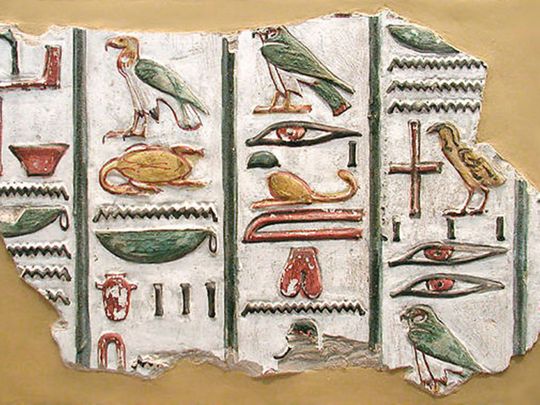
If you enter a 4,400-year-old royal tomb in Saqqara, Egypt, and observe the columns of hieroglyphs lining the walls, you’ll come across something mind-blowing.
Click start to play today’s Spell It, where we learn about Egyptian technology that ‘outlasts’ many of our own modern-age inventions.
On the walls of the tomb of Unas, the last ruler of the fifth dynasty in Egypt, are symbols from one of the oldest writing systems in the world, depicting snakes, vultures, eyes, feet, half circles and more. But the symbol that’s arguably most fascinating is one that’s shaped like a bowl, with a horizontal line just beneath the brim. It represents iron.
Here’s what’s strange about this symbol – humans didn’t learn to smelt iron until roughly a thousand years later. So, how did ancient Egyptians source iron, and make incredible ornaments and weapons from it?
The answer lies in the stars. More specifically, meteorites. According to a May 2023 report in the National Geographic, over the past decade, several artifacts have been found across ancient civilisations, which indicate that people knew how to craft objects from fallen meteorites.
Some of the oldest known objects made from space metals were ornaments. For instance, in a cemetery called Gerzeh, along the river Nile in Egypt, archaeologists found nine beads made from a meteoritic metal – the beads are 5,200 years old. Axes made from meteorites have been found in China, an iron dagger found in Turkey, and jewellery in North America.
It's unclear whether most cultures knew where the meteorites came from. But in the case of Egypt, and Unas’s tomb, funerary texts talk about ‘metal of the sky’. A sentence found in Unas’s tomb, for instance, reads: “Unas grabs the sky and splits its iron.” This means ancient Egyptians didn’t just know how to craft from meteorite, they knew where it came from and held it in high esteem.
Meteorites have been crashing to the Earth since time immemorial. According to an April 2020 study in the journal Geology, around 17,600 meteorites weighing more than 50g reach Earth, every year. They usually fall unnoticed, and people only witness about five of these falling rocks per year.
It was in Greece and Rome that people first recorded a possible meteorite fall. Greek philosophers, like Aristotle and Plutarch, wrote about a stone landing in around 467BC in what is now Turkey. Plutarch recounted how a meteorite may have actually disrupted a battle in the first century BC: “As they were on the point of joining battle, with no apparent change of weather, but all on a sudden, the sky burst asunder, and a huge, flamelike body was seen to fall between the two armies. In shape, it was most like a… jar and in colour, like molten silver.”
Although ancient civilisations initially began shaping meteorites into jewellery, as they honed their techniques, they were able to produce weapons and tools. Egyptian king Tutankhamun’s dagger, for instance, was made in the Late Bronze Age – it was expertly crafted, with a gold hilt that had stone and glass inlays, and a pommel of rock crystal. King Tut was buried with it, in a sheath on his right thigh.
Ancient civilisations were far more discerning about the universe and their place in it, than we often give them credit for. By the 13th century BC, the idea of iron from the cosmos was so well known, it became part of the Book of the Dead – ancient Egyptian funerary texts written on papyrus.
In one section, the book describes a great fishing net, which is thought to be the barrier that the deceased must navigate past, in their journey to the afterlife. The Book of the Dead describes it with these telling words: “Do you know that I know the name of its weights? It is the iron in the midst of the sky.”
What do you think of this remarkable craftsmanship by ancient civilisations? Play today’s Spell It and tell us at games@gulfnews.com.








